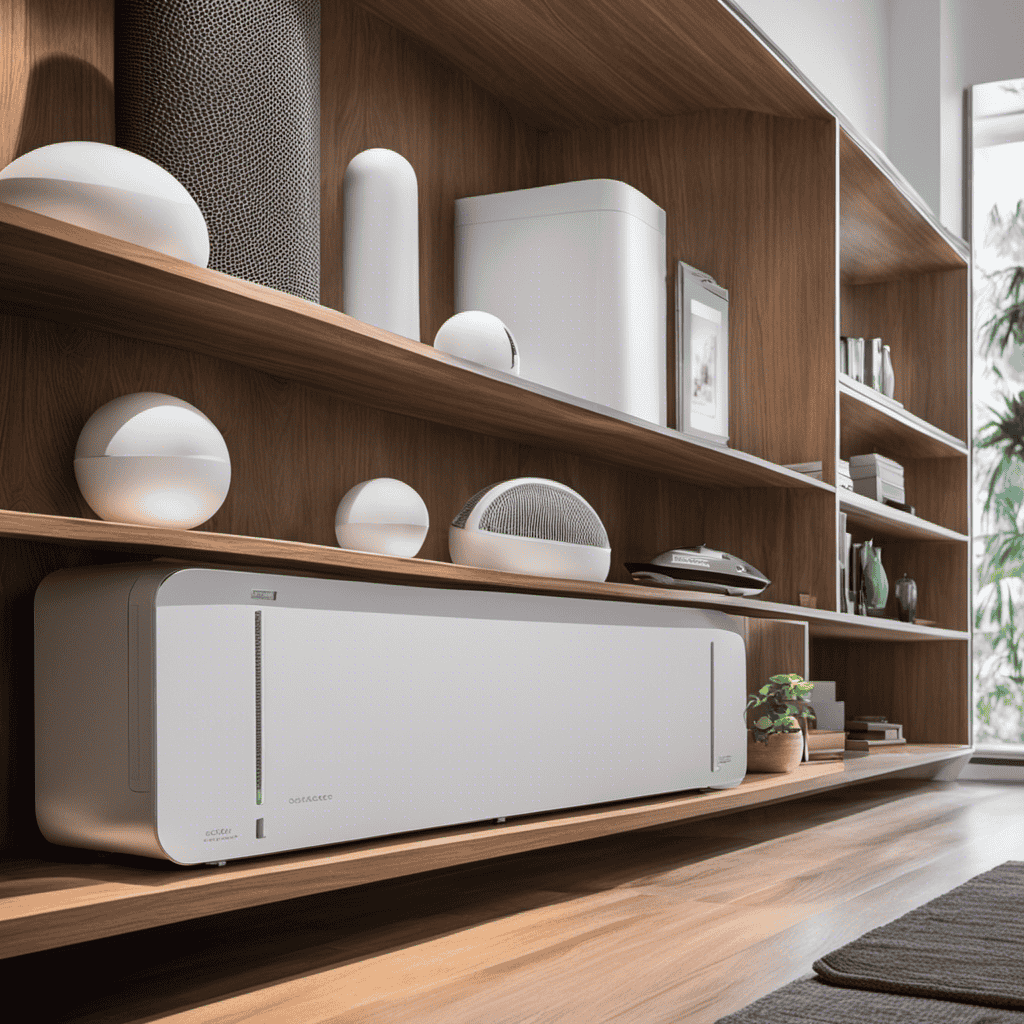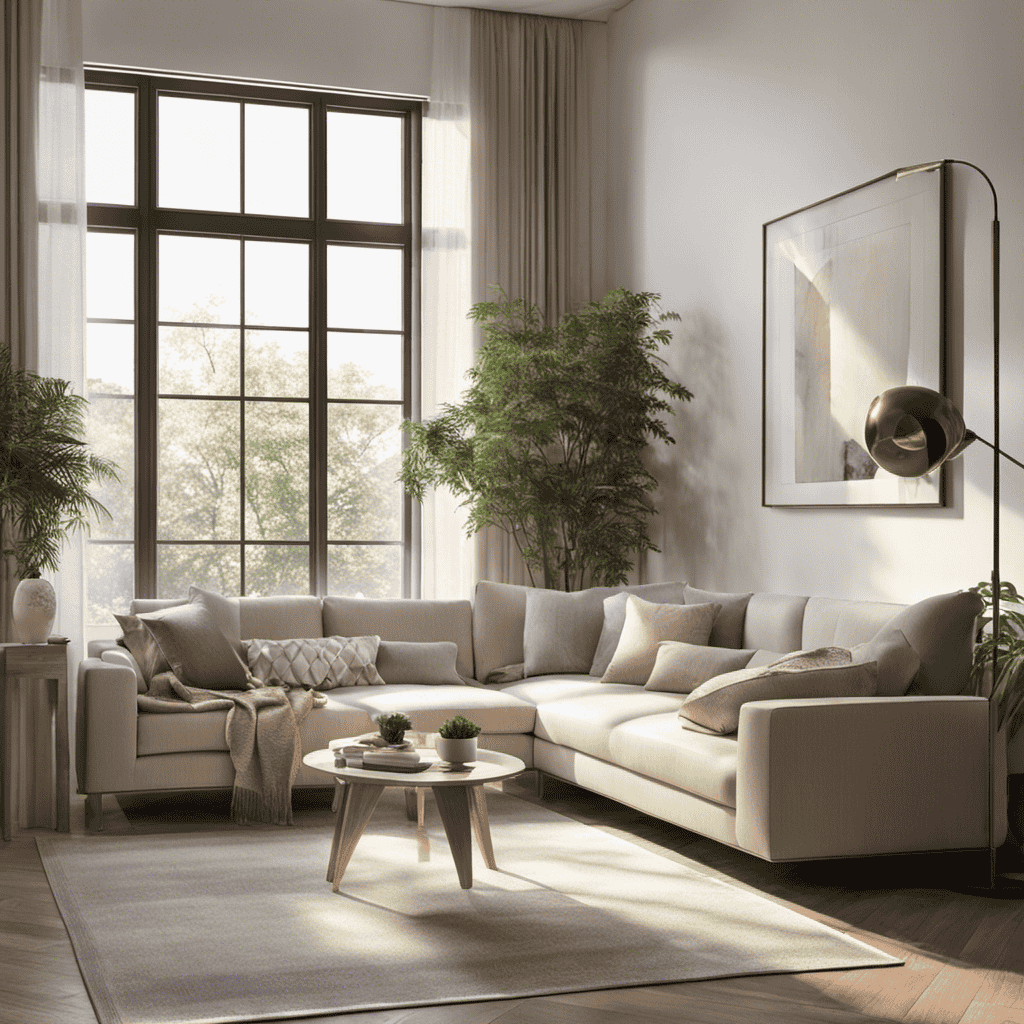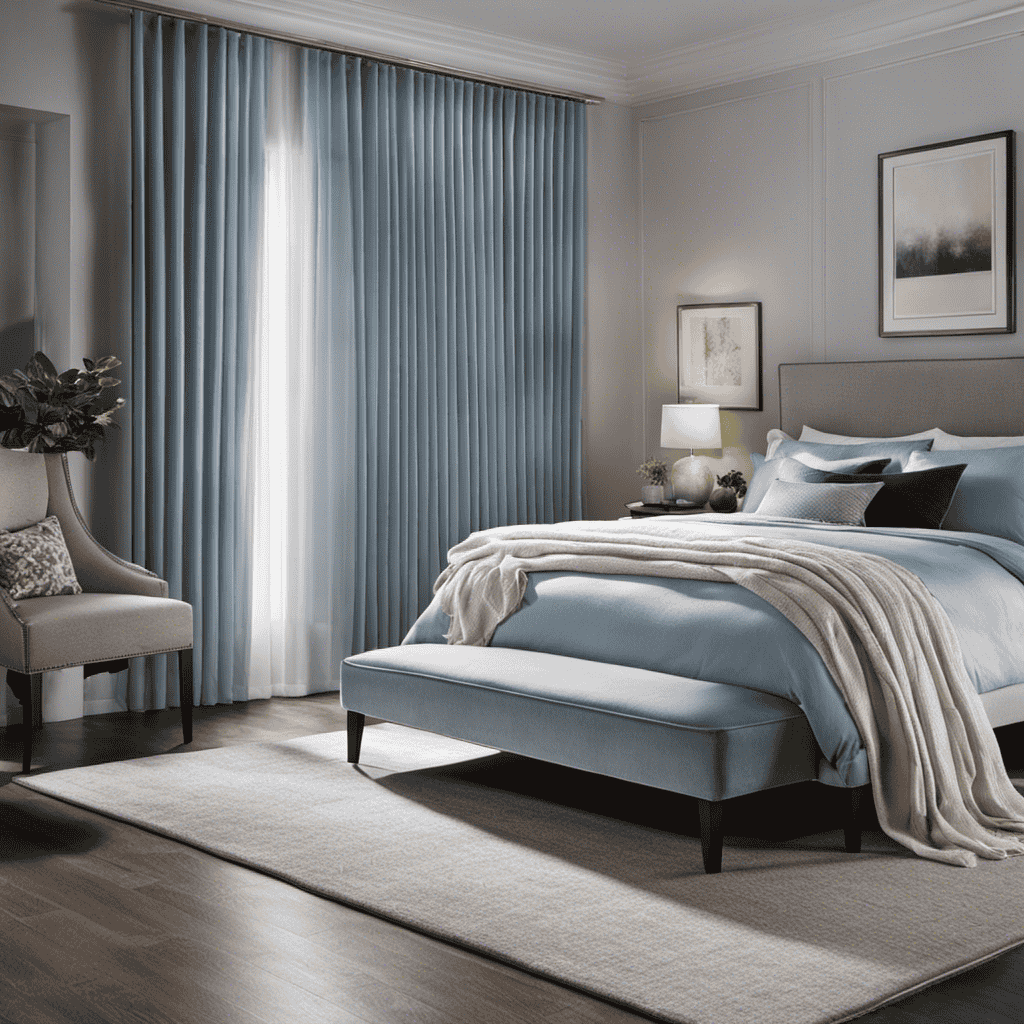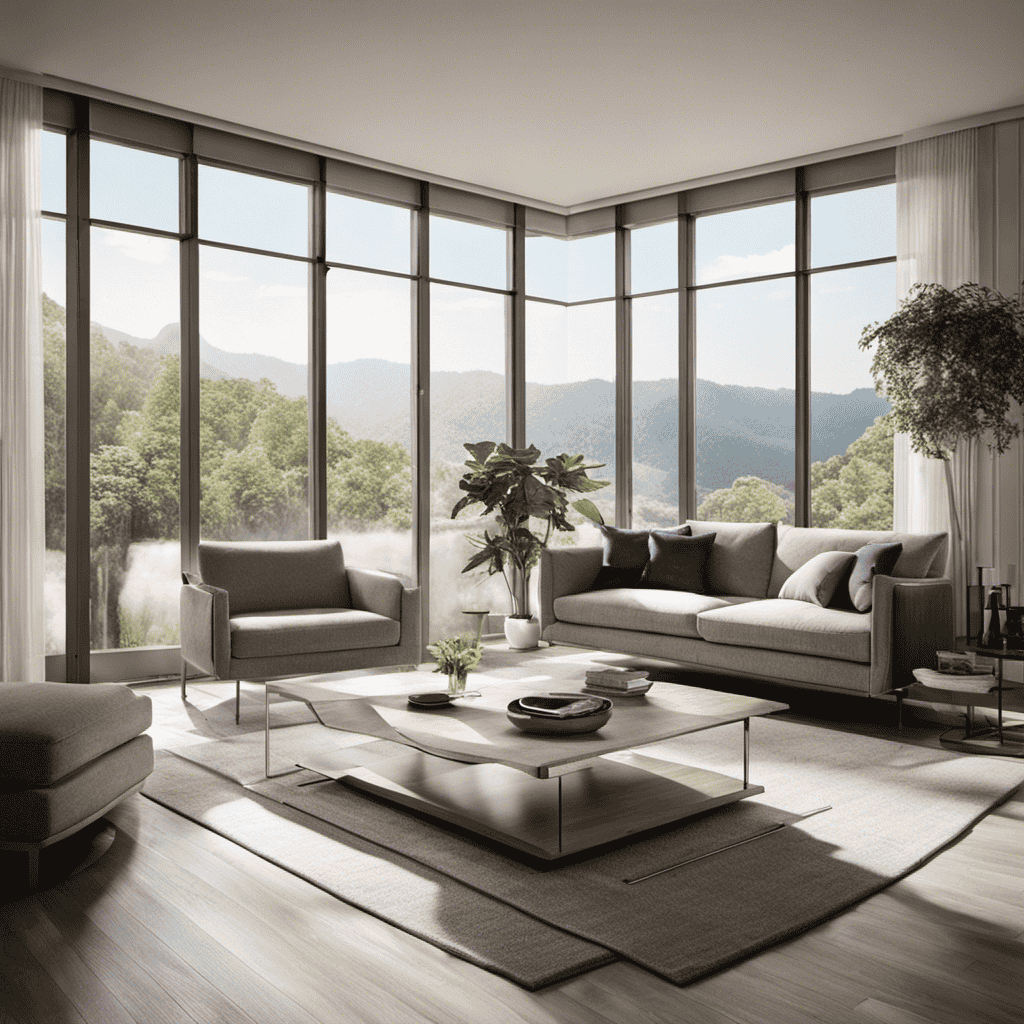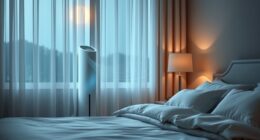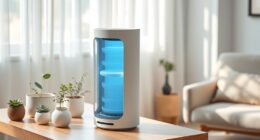As a person who has always been mindful of the air quality in my home, I have frequently pondered, “How much does an air purifier cost?” The answer, I must admit, is not as simple as one might assume.
There are various factors that affect the cost, such as the type of air purifier and the size of the area it can cover.
In this article, we’ll explore the different price ranges of air purifiers, from budget-friendly options to high-end models, so you can make an informed decision for your specific needs.
Key Takeaways
- The cost of an air purifier is affected by factors such as filter efficiency and noise levels.
- Different types of air purifiers have different price ranges.
- Budget-friendly air purifiers under $100 are available and effectively remove allergens and odors.
- High-end air purifiers over $300 offer cutting-edge technology and the best air purification solutions.
Factors Affecting the Cost of Air Purifiers
When shopping for an air purifier, you may be wondering what factors affect the cost. Two important factors to consider are filter efficiency and noise levels.
Filter efficiency refers to how effectively the air purifier removes pollutants from the air. Higher filter efficiency generally leads to a higher cost as it requires more advanced technology and materials.
Noise levels also play a role in determining the cost of an air purifier. Some models are designed to operate silently, while others may produce more noise due to powerful fans or other components. Quieter models tend to be more expensive as they require additional soundproofing measures.
Understanding these factors can help you make an informed decision and find an air purifier that fits your needs and budget.
Types of Air Purifiers and Their Price Range
There are various types of air purifiers available, and their price range can vary. When it comes to mid-range air purifiers, one of the most common types is those with HEPA filters. HEPA filters are highly effective in removing airborne particles, such as dust, pollen, and pet dander. The cost of these filters can range anywhere from $20 to $100, depending on the brand and size of the purifier.
Some mid-range air purifiers also come with additional features like activated carbon filters for odor removal or UV-C lights for germicidal purposes. These extra features can slightly increase the price, but they provide added benefits in terms of air purification.
Now, let’s move on to budget-friendly air purifiers under $100.
Budget-Friendly Air Purifiers Under $100
If you’re looking for a budget-friendly option, you can find air purifiers under $100. These affordable filtration options provide an effective way to improve the air quality in your home without breaking the bank.
Here are three compact purifiers that you can consider:
-
The GermGuardian AC4100 is a compact and portable air purifier that is perfect for smaller spaces such as bedrooms or offices. It features a 3-in-1 filtration system that includes a HEPA filter, a charcoal filter, and UV-C light technology to capture and eliminate airborne pollutants.
-
The Hamilton Beach TrueAir is another affordable option that offers a simple and compact design. It uses a two-stage filtration system to remove allergens, dust, and odors from the air. It also comes with a permanent filter that can be easily cleaned and reused.
-
The Levoit LV-H132 is a popular choice for those on a budget. Despite its compact size, it boasts a three-stage filtration system that includes a pre-filter, a HEPA filter, and an activated carbon filter to effectively remove allergens, smoke, and pet dander.
These budget-friendly options provide reliable air purification without breaking the bank. However, if you’re willing to invest a bit more, there are also mid-range air purifiers available between $100 and $300.
Mid-Range Air Purifiers Between $100 and $300
When it comes to air purifiers, there are options available for every budget.
In the previous subtopic, we discussed budget-friendly air purifiers under $100.
Now, let’s shift our focus to the mid-range options, ranging from $100 to $300.
Additionally, for those seeking top-notch air purification technology and are willing to invest more, there are high-end options available that offer advanced features and superior performance.
Budget-Friendly Air Purifiers
You can find budget-friendly air purifiers that are affordable and effective. These air purifiers may not have all the bells and whistles of their more expensive counterparts, but they still do a great job of improving the air quality in your home.
Here are three reasons why budget-friendly air purifiers are worth considering:
-
Affordable filters: Budget-friendly air purifiers often come with low-cost replacement filters. These filters may not last as long as more expensive ones, but they still effectively remove dust, pollen, and other allergens from the air.
-
Effective technology: Despite their lower price, budget-friendly air purifiers still use effective technology to clean the air. They typically employ HEPA filters or other advanced filtration systems that can capture even the smallest particles.
-
Reliable performance: While they may not have all the fancy features of higher-end models, budget-friendly air purifiers are still reliable performers. They can effectively remove odors, reduce airborne contaminants, and improve overall air quality in your home.
High-End Options Available
Looking for top-of-the-line air purifiers? High-end options offer cutting-edge technology and superior performance. These luxury air purification options come packed with features that ensure clean and fresh air in your home. Let’s take a closer look at some of the high-end air purifier features available in the market:
| Features | Description | Benefits |
|---|---|---|
| HEPA Filters | High-efficiency particulate air (HEPA) filters can capture and remove 99.97% of particles as small as 0.3 microns, including allergens, dust, and pet dander. | Provides cleaner and healthier air for those with allergies or respiratory issues. |
| Smart Sensors | Advanced sensors detect air quality and adjust the purifier’s settings accordingly, ensuring optimal performance. | Automatically adjusts fan speed and filtration levels based on the air quality, saving energy and maximizing effectiveness. |
| UV-C Light Technology | UV-C light kills bacteria, viruses, and mold spores, improving indoor air quality. | Helps eliminate harmful pathogens and provides an extra layer of protection against airborne illnesses. |
These high-end air purifiers offer the latest technology and exceptional performance, making them worth the investment for those seeking the best air purification solutions.
High-End Air Purifiers Over $300
If you’re in the market for a high-end air purifier, expect to pay over $300. These top-of-the-line air purifiers offer advanced air filtration systems that are designed to remove even the smallest pollutants from the air.
Here are three reasons why high-end air purifiers are worth the investment:
-
Superior Filtration Technology: High-end air purifiers are equipped with advanced filters that can capture particles as small as 0.3 microns. This means they can effectively remove allergens, dust, pet dander, and even smoke from the air.
-
Multiple Filtration Stages: These air purifiers often have multiple filtration stages, including pre-filters, activated carbon filters, and HEPA filters. Each stage targets different types of pollutants, resulting in cleaner and fresher air.
-
Smart Technology: Many high-end air purifiers come with smart features such as Wi-Fi connectivity and smartphone apps. This allows you to monitor and control the air purifier remotely, ensuring that your indoor air quality is always at its best.
Investing in a high-end air purifier is a great way to improve the air quality in your home or office. With their advanced filtration systems and smart technology, these purifiers offer unparalleled performance and convenience.
The Cost of HEPA Filters and Replacement
When it comes to air purifiers, one important aspect to consider is the lifespan and cost of the filters.
The filter lifespan can vary depending on the model and usage, ranging from a few months to a year or more.
It is crucial to factor in the cost of replacement filters, as they can add up over time and significantly impact long-term maintenance expenses.
Filter Lifespan and Cost
The lifespan of air purifier filters can vary, but they typically last between six months and one year. Proper filter replacement and maintenance are crucial to ensure the effectiveness of an air purifier and to keep maintenance expenses in check. Here are a few important points to consider:
-
Regular filter replacement: It is important to follow the manufacturer’s guidelines for filter replacement. This ensures that the air purifier continues to effectively remove pollutants from the air.
-
Filter maintenance: In addition to regular replacement, filters should also be cleaned or vacuumed regularly to remove any accumulated dust or debris. This helps prolong the lifespan of the filter and maintain the air purifier’s efficiency.
-
Cost considerations: The cost of filter replacement can vary depending on the brand and model of the air purifier. It is important to factor in the cost of filters when considering the overall maintenance expenses of an air purifier.
Different Filter Price Ranges
You can find air purifier filters in a range of prices, allowing you to choose one that fits your budget.
When it comes to HEPA filters, they are considered to be the most effective at removing small particles from the air. The prices for HEPA filters can vary depending on the brand and model of the air purifier.
In general, you can expect to pay anywhere from $10 to $50 for a replacement HEPA filter. However, there are also cost-effective options available, such as generic or off-brand filters, which can be purchased for a lower price.
These filters may not be as high quality as the more expensive ones, but they can still effectively remove a significant amount of pollutants from the air.
Long-Term Maintenance Expenses
When considering the cost of an air purifier, it’s important to think beyond the initial purchase price. Long-term maintenance expenses, such as filter replacements, should also be taken into account. Filters play a crucial role in removing pollutants from the air, but they have a limited lifespan. Here are some key points to consider:
-
Filter Lifespan: Different air purifiers have varying filter lifespans, ranging from a few months to a year or more. It’s essential to check the manufacturer’s recommendations for filter replacement intervals.
-
Filter Replacement Cost: Filters can range in cost depending on the type and brand of the air purifier. Some filters may be more expensive but last longer, while others may be cheaper but require more frequent replacements.
-
Overall Maintenance Costs: Consider the long-term expenses of replacing filters over the lifespan of the air purifier. These costs can add up and should be factored into the total cost of owning and operating the unit.
Considering maintenance expenses is crucial to understanding the true cost of an air purifier. Now, let’s explore additional features and their impact on price.
Additional Features and Their Impact on Price
Consider looking into air purifiers with additional features as they can have a significant impact on the overall price.
One such feature to consider is smart technology. Smart air purifiers are equipped with advanced sensors that monitor air quality and adjust the purification settings accordingly. These devices can be controlled remotely through smartphone apps, offering convenience and flexibility. However, it’s important to note that air purifiers with smart technology tend to be more expensive than their traditional counterparts.
Another feature to consider is the noise level. Some air purifiers are designed to operate silently, while others may emit a noticeable amount of noise. If you value a quiet environment, it’s worth investing in a purifier with a low noise level. However, keep in mind that air purifiers with noise-reducing technology may come at a higher price point.
Maintenance Costs of Air Purifiers
To keep maintenance costs low, it’s important to regularly clean and replace the filters in your air purifier. This will ensure that your air purifier continues to function effectively and efficiently, providing you with clean and healthy air.
Here are some tips to help you manage the maintenance costs of your air purifier:
-
Cleaning the filters: Regularly cleaning the filters will help prolong their lifespan and maintain their effectiveness. Use a soft brush or vacuum cleaner to remove any dust or debris from the filters.
-
Replacing the filters: Over time, the filters in your air purifier will become less effective and may need to be replaced. HEPA filters, in particular, are known for their high efficiency in capturing small particles. While the prices of HEPA filters may vary, they are generally considered a worthwhile investment for long-term maintenance costs.
-
Following manufacturer’s recommendations: Each air purifier may have specific maintenance requirements. It’s important to follow the manufacturer’s recommendations for filter replacement and overall maintenance to ensure optimal performance and minimize long-term costs.
Energy Efficiency and Operating Costs
You can save money on your electricity bills by choosing an energy-efficient air purifier. When it comes to energy consumption, not all air purifiers are created equal. Look for models that are Energy Star certified, as they are designed to use less electricity while still providing effective air purification.
These energy-saving features can help reduce your overall energy consumption and lower your electricity bills. Additionally, some air purifiers come with cost-saving features such as programmable timers and auto-shutoff functions. These features allow you to set specific operating times, ensuring that the purifier only runs when needed.
Long-Term Cost Considerations of Air Purifiers
One important factor to keep in mind when thinking about long-term expenses is the maintenance requirements of the air purifier. Proper maintenance ensures the longevity and efficiency of the device, ultimately leading to long-term cost savings.
Here are three key considerations to keep in mind when evaluating the long-term cost of air purifiers:
-
Filter Replacement: Air purifiers typically require regular filter replacements to maintain their effectiveness. It is important to consider the cost and frequency of filter replacements when calculating long-term expenses.
-
Energy Efficiency: Look for energy-efficient air purifiers that consume less electricity. This can help reduce operating costs over time.
-
Cost Comparison: When evaluating the long-term cost of air purifiers, it is essential to compare them with other air quality solutions such as HVAC systems or whole-house air purifiers. Consider factors like initial purchase price, maintenance costs, and energy efficiency to make an informed decision.
Taking these factors into account will help you make a well-informed decision regarding the long-term cost of air purifiers and their comparison with other air quality solutions.
Comparing Costs: Air Purifiers Vs. Other Indoor Air Quality Solutions
When comparing air purifiers to other indoor air quality solutions, it’s important to consider factors like initial purchase price, maintenance costs, and energy efficiency. While air purifiers are a popular choice for improving indoor air quality, there are also affordable alternatives and cost-efficient options available. To help you make an informed decision, here is a comparison table highlighting some key aspects:
| Air Purifiers | Other Indoor Air Quality Solutions |
|---|---|
| Initial purchase price | Can vary depending on the brand and features |
| Maintenance costs | Filters need to be replaced regularly, which can add up over time |
| Energy efficiency | Many models are designed to be energy-efficient and have low power consumption |
| Coverage area | Different purifiers are suited for different room sizes |
| Effectiveness | Air purifiers are highly effective at removing allergens, pollutants, and odors |
While air purifiers might have a higher initial cost and ongoing maintenance expenses, they provide excellent air purification capabilities. However, if you’re looking for more affordable alternatives or cost-efficient options, you can explore options like ventilation systems, plants for natural air purification, and regular cleaning and dusting routines. These alternatives can be effective in improving indoor air quality while being more budget-friendly.
Affordable Air Purifiers for Small Spaces
When it comes to finding budget-friendly purification options for small spaces, there are a few key points to consider.
Firstly, compact air cleaning solutions are a great choice for those looking to save on both space and cost. These smaller units are designed to effectively clean the air in small rooms or areas, without breaking the bank.
Additionally, cost-effective small space purifiers are available in a range of prices, allowing consumers to find the perfect option to suit their budget without sacrificing performance.
Budget-Friendly Purification Options
If you’re on a budget, you can find affordable air purifiers that are effective at filtering out pollutants. Here are three affordable filtration options that won’t break the bank:
-
HEPA Filters: High-Efficiency Particulate Air (HEPA) filters are known for their ability to remove 99.97% of airborne particles as small as 0.3 microns. These filters are widely available and can be found in many budget-friendly air purifiers.
-
Activated Carbon Filters: These filters are excellent at trapping odors, chemicals, and gases. They work by adsorbing these pollutants onto a porous carbon surface. Activated carbon filters are often used in combination with HEPA filters to provide comprehensive air cleaning.
-
Ionizers: Ionizers emit negative ions into the air, which attach to positively charged pollutants, causing them to fall out of the air. While ionizers may not be as effective as HEPA filters, they can still provide some level of air purification at a lower cost.
When looking for cheap air cleaning devices, keep in mind that cost should not be the only factor to consider. It’s important to ensure that the air purifier you choose is suitable for the size of your room and meets your specific air quality needs.
Compact Air Cleaning Solutions
Compact air purifiers are an ideal option for small spaces or rooms with limited space. These compact devices are designed to effectively clean the air in smaller areas, providing you with fresh and breathable air.
When it comes to the price range of compact air purifiers, it can vary depending on the brand, features, and filtration technology. Generally, you can find compact air purifiers priced between $50 to $200.
It’s important to note that while these devices may have a smaller size, they still offer powerful air purification capabilities. When comparing the cost of portable air purifiers, it’s essential to consider factors such as the coverage area, filter replacement frequency, and additional features like timers or air quality sensors.
Cost-Effective Small Space Purifiers
To find a budget-friendly option for purifying small spaces, you should consider comparing different models and their specific features. There are several cost-efficient filtration systems and affordable air sanitizers available in the market.
Here are three options to consider:
-
Model A: This compact air purifier is equipped with a HEPA filter that efficiently captures airborne particles, including dust, pollen, and pet dander. It also has a carbon filter to eliminate odors and harmful gases. Despite its small size, it covers up to 150 square feet of space, making it suitable for bedrooms or offices.
-
Model B: With its 3-stage filtration system, this air purifier effectively removes allergens, mold spores, and bacteria from the air. It features a UV-C light that helps kill germs and a pre-filter to capture larger particles. This model is ideal for small living rooms or kitchens, covering up to 200 square feet.
-
Model C: This affordable air sanitizer utilizes a combination of an activated carbon filter and a photocatalyst filter to eliminate odors and harmful substances. It has a compact design and covers up to 100 square feet, making it perfect for bathrooms or closets.
Premium Air Purifiers for Large Areas
You might want to consider investing in a premium air purifier for large areas if you’re looking to improve the air quality in your home. These air purifiers are specifically designed to cover larger spaces, ensuring that every corner of the room is effectively purified. While they may come at a higher price compared to smaller purifiers, the benefits they provide are well worth it. Premium air purifiers typically have advanced filtration systems that can capture a wide range of pollutants, including dust, pollen, pet dander, and even harmful gases. They also often have additional features such as smart controls, air quality sensors, and quiet operation. Here is a comparison table to help you choose the right premium air purifier for your large room:
| Brand | Coverage Area | Filtration System | Additional Features |
|---|---|---|---|
| Brand A | Up to 800 sq ft | HEPA + Activated Carbon | Smart Controls |
| Brand B | Up to 1,000 sq ft | True HEPA + Carbon Filters | Air Quality Sensor |
| Brand C | Up to 1,200 sq ft | HyperHEPA + Carbon Filters | Quiet Operation |
| Brand D | Up to 1,500 sq ft | HEPA + Carbon + UV | Timer Function |
| Brand E | Up to 2,000 sq ft | True HEPA + Ionizer | Remote Control |
With a premium air purifier for large areas, you can breathe easier knowing that your entire home is protected from harmful pollutants.
Cost-Effective Air Purifiers for Allergen Control
When it comes to allergen control, cost-effective air purifiers are a great option. Not only do they help improve indoor air quality, but they also come at an affordable price. Here are some key features and cost-saving maintenance tips for these air purifiers:
-
Affordable HEPA filters: These air purifiers often come with HEPA filters, which are highly effective at capturing allergens like pollen, dust mites, and pet dander. The filters are reasonably priced and can be easily replaced when needed.
-
Energy-efficient operation: Look for air purifiers with energy-saving features, such as programmable timers and sleep modes. These can help reduce electricity consumption and save on utility bills.
-
Regular cleaning and maintenance: To optimize the performance and lifespan of your air purifier, it’s important to clean and maintain it regularly. This includes vacuuming or wiping the exterior, cleaning the filters, and checking for any clogs or blockages.
Investing in Air Purifiers for Health Benefits
Investing in an air purifier can greatly improve your health and provide numerous benefits.
Air purifiers are particularly beneficial for individuals with allergies, as they can effectively remove allergens such as pollen, dust mites, and pet dander from the air. By reducing the presence of these allergens, air purifiers can significantly alleviate allergy symptoms and provide relief.
Moreover, air purifiers play a crucial role in improving respiratory health. They can filter out harmful pollutants and particles, such as smoke, mold spores, and bacteria, which can trigger respiratory conditions like asthma and bronchitis. Clean air is essential for maintaining healthy lungs and preventing respiratory diseases.
Therefore, investing in an air purifier is a wise choice for those seeking to improve their overall well-being and enjoy the benefits of cleaner, healthier air.
Frequently Asked Questions
Can an Air Purifier Completely Eliminate All Allergens in a Room?
An air purifier can greatly reduce allergens in a room, but it may not completely eliminate them. While effective, air purifiers have limitations and may not be able to remove all allergens, especially if they are deeply embedded or constantly reintroduced into the space.
How Often Do I Need to Replace the Filters in an Air Purifier?
The frequency of filter replacement in an air purifier depends on factors such as usage and the quality of the filters. Replacement filters can range in cost from $10 to $100.
Are Higher-Priced Air Purifiers More Effective Than Budget-Friendly Ones?
Higher-priced air purifiers are often marketed as more effective, but an affordability analysis reveals that budget-friendly options can also provide excellent performance. To determine the best choice, it’s important to compare the effectiveness of different models.
Do Air Purifiers Increase Electricity Bills Significantly?
Air purifiers can increase electricity bills, but the amount varies depending on the model. However, it’s important to consider the long-term cost effectiveness of an air purifier in terms of improved air quality and potential health benefits.
Can Using an Air Purifier Reduce the Need for Other Indoor Air Quality Solutions?
Using an air purifier can significantly reduce the need for other indoor air quality solutions. It can help reduce respiratory symptoms and provide long-term health benefits. It’s a cost-effective investment in your well-being.
Conclusion
After exploring the cost of air purifiers, it is clear that these devices can range in price depending on various factors. From budget-friendly options under $100 to high-end models exceeding $300, there are choices available for every budget.
Whether you have a small space or a large area to cover, affordable and premium air purifiers can cater to your needs. Investing in an air purifier not only helps control allergens but also promotes better health.
So why wait? Get yourself an air purifier and experience the extraordinary transformation it brings to your indoor environment.
